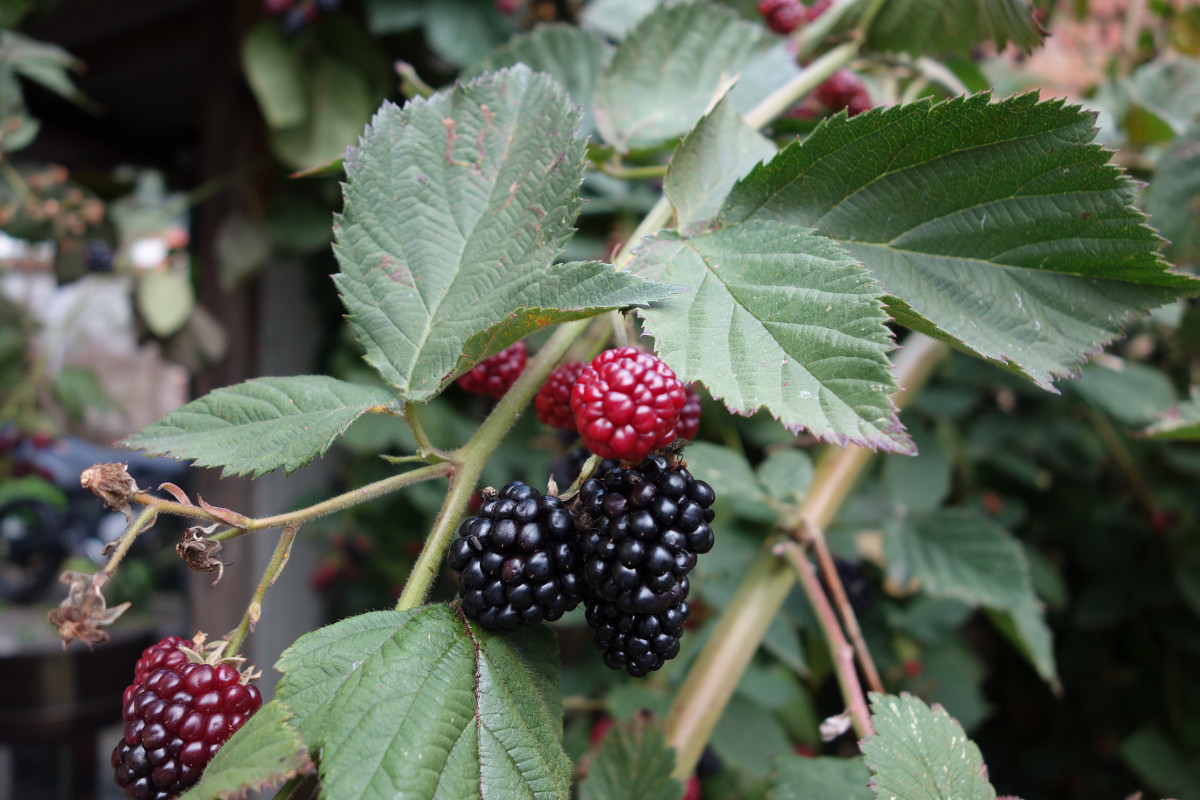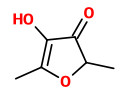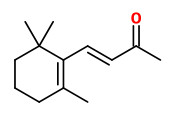Rubus fruticosus agg. l. - Rosaceae - blackberry, bramble, Brombeere
Deciduous shrub, up to 3m high; leaves odd-pinnate (3 or 5 leaflets); leaflets big, ovate, above glabrous, below white hairy, petioles spiny; flower petals white or pale red; berries black.
„Blackberries are perennial plants which typically bear biennial stems („canes“) from the perennial root system. In its first year, a new stem, the primocane, grows vigorously to its full length of 3-6 m (in some cases, up to 9 m), arching or trailing along the ground and bearing large palmately compound leaves with five or seven leaflets; it does not produce any flowers. In its second year, the cane becomes a floricane and the stem does not grow longer, but the lateral buds break to produce flowering laterals (which have smaller leaves with three or five leaflets).“ http://en.wikipedia.org/wiki/Blackberry
„The fruits are juicy and tasty and can be collected from July to October. The blue-black color of the outer skin and the red color of the berry juice is caused by anthocyanins. Here, the juice comprises cyanidin-3-O-glucoside as the main component.“ http://de.wikipedia.org/wiki/Brombeere
Alcohols, furans and aldehydes are the predominant chemical classes of heated blackberry juices, the most abundant compound being 2-heptanol (green lemongras-like) in the cultivated variety and furfural (sweet almond-like) in the wild blackberry varieties.
[Georgilopoulos, Dimitris N., and Annie N. Gallois. „Volatile flavour compounds in heated blackberry juices.“ Zeitschrift für Lebensmittel-Untersuchung und Forschung 185.4 (1987): 299-306]
The aroma of commercial blackberry juice has been found mainly due to the presence of furfural (which represents a third of the total odorous profile), 3-methyl-butanal, 3-methyl-1-butanol, phenylacetaldehyde and trans-furan linalool oxide.
[Flavour compounds of a commercial concentrated blackberry juice. Georgilopoulos, Dimitris N., and Annie N. Gallois, Food chemistry 28.2 (1988), 141-148]
„The most significant (FD>16) odor-active volatiles in 'Marion' determined on the non-polar (DB-5) column were methional (FD = 256); ethyl 2-methylbutanoate (FD = 128); benzaldehyde and hexanal (FD = 64); 2-methylbutanoic acid, 2,5-dimethyl-4-hydroxy-3(2H)-furanone, 4,5-dimethyl-3-hydroxy-2(5H)-furanone, ethyl hexanoate, dimethyldisulfide, and 2-methylthiophene (FD = 32); linalool, neo-allo-ocimene, dimethylsulfide, dimethyltrisulfide, and methylethylsulfide (FD = 16). In addition, 2-ethyl-4-hydroxy-5-methyl-3(2H)-furanone, 4-hydroxy-5-methyl-3(2H)-furanone, and butanoic acid (FD = 32), ethyl acetate, acetic acid, and 2-heptanone (FD = 16) may also be important to 'Marion' blackberry flavor, as they had high flavor dilution factors as determined on the polar (Stabilwax) column.“
[Klesk, Keith. „Aroma comparison of 'Marion'(Rubus sp. L.) and 'Thornless Evergreen'(R. laciniatus L.) blackberries.“ (2003)]
https://ir.library.oregonstate.edu/downloads/w37639265
„Cultivar Marion and Evergreen blackberry aromas were analyzed by aroma extract dilution analysis. Sixty-three aromas were identified (some tentatively) by mass spectrometry and gas chromatography−retention time; 48 were common to both cultivars, and 27 have not been previously reported in blackberry fruit. A comparison of cultivars shows that both have comparable compound types and numbers but with widely differing aroma impacts, as measured by flavor dilution (FD) factors. Ethyl 2-methylbutanoate, ethyl 2-methylpropanoate, hexanal, furanones (2,5-dimethyl-4-hydroxy-3-(2H)-furanone, 2-ethyl-4-hydroxy-5-methyl-3-(2H)-furanone, 4-hydroxy-5-methyl-3-(2H)-furanone, 4,5-dimethyl-3-hydroxy-2-(5H)-furanone, and 5-ethyl-3-hydroxy-4-methyl-2-(5H)-furanone), and sulfur compounds (thiophene, dimethyl sulfide, dimethyl disulfide, dimethyl trisulfide, 2-methylthiophene, and methional) were prominent in Evergreen (FD 512−2048). Except for ethyl 2-methylpropanoate, these same compounds were also prominent in Marion, but the FD factors varied significantly (FD 8−256) from Evergreen. The aroma profile of blackberry is complex, as no single volatile was unanimously described as characteristically blackberry.“
[Klesk, Keith, and Michael Qian. „Aroma extract dilution analysis of cv. Marion (Rubus spp. hyb) and cv. Evergreen (R. laciniatus L.) blackberries.“ Journal of agricultural and food chemistry 51.11 (2003): 3436-3441]
„The aroma constituents of thornless ‘Black Diamond’ blackberry were isolated by dichloromethane liquid-liquid extraction followed by solvent-assisted flavor evaporation. The results indicated the most potentially important odor-active compounds in ‘Black Diamond’ was ethyl butanoate, ethyl hexanoate, 1-octen-3-one, 2-heptanol, cis-3-hexenol, nonanal, trans-2-hexenol, methional, linalool, ethyl 3-hydroxyhexanoate, α-ionone, β-ionone, furaneol, and 5-isoprenyl-2-dimethyl-divinyltetrahydrofuran.“
[Fractionation and Identification of Aroma-Active Constituents in Thornless Trailing 'Black Diamond' Blackberry., Du, X., Qian, M., In ACS symposium series, Oxford University Press, vol.1035, 2010, 45-61]
„‘Black Diamond’ is a recently developed thornless blackberry cultivar with large fruit size, high yield, and good processed fruit quality that has rapidly become an industry standard. The flavour of ‘Black Diamond’ fruit is not the same as ‘Marion’, which is regarded by the industry as having the ideal flavour… Odour-activity value (OAV) indicated that furaneol, linalool, β-ionone, and hexanal could be most important in ‘Marion’, while in ‘Black Diamond’, the most important compounds were linalool, β-ionone, furaneol, and 2-heptanol. The major difference between the cultivars for aroma compounds was that ‘Marion’ had a 5 times higher OAV of furaneol than ‘Black Diamond’, while ‘Black Diamond’ had a 3 times higher OAV of linalool than ‘Marion’. The chemical analysis results matched with the descriptive sensory evaluation that ‘Marion’ had more berry, fruity, strawberry aroma while ‘Black Diamond’ had more floral aroma.“
[Volatile composition and odour-activity value of thornless ‘Black Diamond’ and ‘Marion’blackberries., Du, Xiaofen, Chad E. Finn, and Michael C. Qian, Food Chemistry 119.3, 2010, 1127-1134] https://www.ars.usda.gov/ARSUserFiles/1718/PDF/2009/2009_Food_chem_in_press.pdf

Kops et al., J., Flora Batava, vol.15, t.1192 (1877)
http://plantgenera.org/species.php?id_species=890210

Rubus fruticosus fruits, CC BY-SA 3.0, Author: Andreas Kraska





